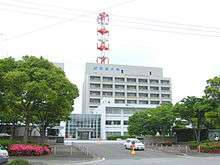The Open University of Japan
| 放送大学 | |
 | |
| Motto | Whenever, Wherever, Whoever |
|---|---|
| Type | Private |
| Established |
Founded 1981 Chartered 1983 |
| President | Dr.Yoichi Okabe |
| Undergraduates | 80,799 (2007) |
| Postgraduates | 6,245 (2007) |
| Location | Wakaba, Mihama-ku, Chiba City, Chiba, Japan |
| Campus | Urban (learning centers) |
| Member of | ICDE |
| Website | www.ouj.ac.jp |
The Open University of Japan (放送大学 Hōsō Daigaku, formerly The University of the Air, the English name of the university was changed on 1 October 2007) is a distance learning university which has students all over Japan; it accepted its first students in 1985.
History
Although founded by the national government initiative with a single-issue law and heavily subsidised by the government, it was established by The University of the Air Foundation (放送大学学園 Hōsō Daigaku Gakuen) as a "special academic incorporation" (特別な学校法人 tokubetsu na gakkō hōjin), the University classified as a private university in Japan.
It was founded on the basic system of The Open University in the United Kingdom. The administration is based in Chiba City although it has offices and learning centers in each of Japan's 47 prefectures. The University offers accredited undergraduate and graduate degrees.
With nearly 90,000 students enrolled (in 2007), 45,000 students graduated from the University. It is one of the largest academic institutions in the nation, and qualifies as one of the world's mega universities. Since it was founded, over 780,000 students have taken courses from the institution.
OUJ as a broadcasting station

The OUJ Academia broadcasts lectures and administrative announcement programs. It owns terrestrial television and radio broadcasting stations at the headquarters in Chiba City. All programs are recorded and edited at the headquarters and transmitted from the Tokyo Tower via UHF television and FM radio, and relayed at Maebashi, Gunma to reach Kantō region as well as on Broadcasting Satellite (BS) channels to reach the whole nation. The broadcasts are exclusively in Japanese language as the medium of instruction. Article 50-4-1 of the Broadcasting Act prohibits the OUJ from broadcasting commercial messages. The cost of the broadcasting system is subsidised by the national budget.
It is not affiliated with any other broadcasting networks (although there were supports from television stations in Tokyo at the beginning). As a television station it is the only purely independent/isolated terrestrial station in Japan.
Broadcast media
Reception is free to the general public.
| Media | Call sign | Broadcasting area |
|---|---|---|
| Television | JOUD-DTV | Tokyo, Kanagawa, Saitama, Chiba, Gunma, Ibaraki and Tochigi |
| FM Radio | JOUD-FM | Tokyo, Kanagawa, Saitama, Chiba, Gunma, Ibaraki and Tochigi |
| Broadcasting Satellite (BS) | — | Nationwide |
Television: Physical channel 28 (preset channel 12; Tokyo and Maebashi).
Radio: 77.1 MHz FM (Tokyo), 78.8 MHz (Maebashi).
BS: Nationwide on channel 231, 232 and 233 for television (the latter two are used for multichannel broadcasting while the former is for regular broadcasting) and channel 531 for radio. No contract charge or subscription fees are charged at OUJ-only recipients. Some cable television and cable radio also re-transmit the broadcasts.